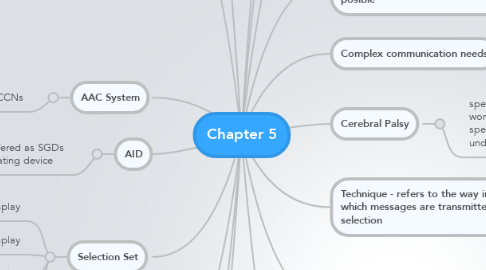Chapter 5
Door Ritchie Ciceron


1. what the ISAAC and the CCNs have adopted to replace terms like severe communication disorders or etc.
2. indirect selection -
2.1. scanning
2.2. directed scanning
2.3. coded scanning
3. communication partners
4. Symbol- somthing that stands for something else
4.1. aided- requires a device or accessory that is external to the body to transmit a message
4.2. unaided - requires only one's body: speaking, gesturing, vocalizing and signing to represent meaning
4.3. acoustic
4.4. Graphic
4.5. Manual
4.6. Tactile
4.7. static- do not require movement or change to understand meaning
4.7.1. Dynamic - requires movement or change to understand meaning
4.8. iconicity- the degree to which symbols virtually resemble what they refer to
4.9. Opaque - little resemblance to what it represents
5. AAC- augmentative and alternative communication
5.1. ASLHA definition- the area of research, clinical, and educational practices that "involves attempts to study and, when necessary, temporarily or permanently compensate for the impairments, activity limitations, and participation restriction of individ with severe disorders of speech-language production and/or compensation
5.2. multimodel - ppl use a combo of communication modalities
5.2.1. augmentative and alternative
6. important point od ch. = communication is the essence of human life, and everyone has the right to communicate to the fullest extent posible
7. Complex communication needs
8. Cerebral Palsy
8.1. speech generating device - used to produce words and phrases as an alternative to to speaking in situations where they are not understood
9. AAC System
9.1. a system for individuals with CCNs
10. AID
10.1. electronic - refered as SGDs speech generating device
11. Technique - refers to the way in which messages are transmitted - selection
11.1. Direct selection - direct motor act that is not dependent on time
12. Selection Set
12.1. fixed display
12.2. dynamic display
12.3. hybrid display
12.4. visual scene
13. purpose of communication
13.1. information transfer
13.2. social closeness
13.3. social etiquette
14. causes of complex communication needs
14.1. intelectual disability
14.2. cerebral palsy
14.3. Autism spectrum disorder
14.4. childhood apraxia of speech
14.5. traumatic brain injury
14.6. stroke
14.7. amyotrophic lateral sclerosis
14.8. Parkinson's disease
14.9. dementia
15. Assessment Process
15.1. comprehensive AAC assessment
15.2. ID of participation patterns
15.2.1. opportunity barriers
15.2.2. access barriers
